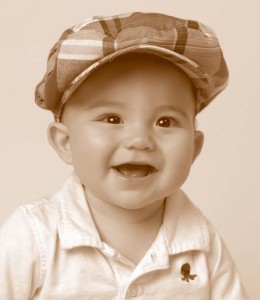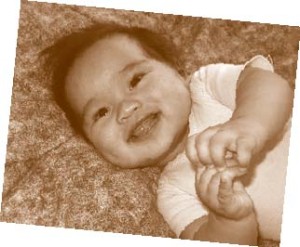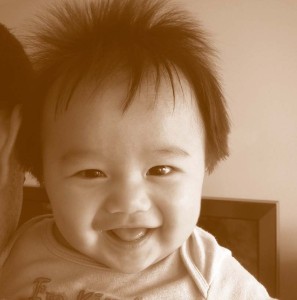Infant & Toddler Development
2–3 Months
Being a parent is a special and important role. You enjoy it but sometimes you may think it’s more of a challenge than you first expected. There are many changes taking place in your life now and many new things to learn. Take pride in what you’ve accomplished. Use the community resources available to you. Keep up the good work!
What it’s like to be 2 months old
How I grow…
- I still wobble my head a little when I am propped up.
- I hold on to things for awhile.
- I wave my arms and legs and “bicycle” with my feet when I get excited.
- I may sleep for as long as seven hours a night, but don’t count on it. Please be patient with me when I wake up during the night.
- I want to explore objects with my hands as well as my eyes.
How I talk…
- I gurgle, laugh, and smile when I’m happy.
- I like to make cooing sounds.
- I cry to let you know when I want something. (I’m probably crying real tears because my tear ducts are developing).
- I also cry when I want company. I may stop when you come near or pick me up.
How I respond…
- I am fascinated by my hands.
- I blink at shadows made by my own hands.
- I follow you with my eyes when you move from one place to another.
- I can follow objects with my eyes.
- I perform just to get your attention.
- I’m starting to smile when I see you.
How I understand…
- I recognize some people by their voices.
- I recognize a few objects—such as my bottle or a favorite rattle.
- I like to stare at people and things around me.
- I have discovered my hand and will stare at it each day. This is the start of curiosity.
How I feel…
- I feel happy, scared, or uncomfortable at times.
How you help me learn…
- Place a mobile or crib gym close enough for me to hit it when I reach the objects with my hands. Make sure the toy is sturdy. I will begin to reach for it and bat at it.
- Rub my body gently after my bath. I like your touch. I also like the feel of soft fabric against my skin.
- Change my position frequently to let me get a new view of the world.
- Let me lie on my back under a tree and watch the leaves blow.
- Take me for a walk or to the store. I like to see and hear what’s happening.
- Put me in a sling or carrier and keep me close to you while you move about the room. Talk to me about what you are doing.
What it’s like to be 3 months old
How I grow…
- I hold my head and back straight when you support my body.
- I lift my head, lean on my elbows, arch my back, and rock when I’m on my stomach.
- I may be able to turn over.
- I can move my arms and legs smoothly and independently.
- I can bring my hands together in front of me.
- I will hold a small object in one hand and finger it with the other.
- I reach for objects with my hand. I like to bat at them, finger them, and put them in my mouth.
How I talk…
- I coo simple sounds, like “ooh” and “ah.”
- I respond to sounds and voices I hear by gurgling, cooing, and squealing.
- I don’t cry as much as before.
- I practice sounds when I’m alone, usually in the early morning.
How I respond…
- I’m becoming more social. I smile at a smiling face. My smile is irresistible.
- I react to familiar faces with my whole body.
- I get excited when I see people I know. When I’m being fed, I stop sucking when I hear sounds. Then I look and suck at the same time.
- I follow sounds with my eyes.
- I like to listen. Talk to me in simple sentences.
How I understand…
- I’m beginning to find out that I am a separate person from you.
- I recognize family members.
How I feel…
- I love being cuddled.
- I don’t like being left alone.
How you help me learn…
- Give me safe, squeaky toys to hold.
- Play pat-a-cake with me.
- Place me in my crib in different positions so that I do not favor one eye as I look around the room.
- Look into my eyes when you talk or sing to me.
- Whisper in my ear. It will be a different sound for me.
- Make sure my mobile or crib gym is secure. I can pull it down if it is too close to me.
Feeding Your Baby
Ready for solid foods?
There are good reasons for waiting to introduce solid foods. Your baby’s digestive system is not yet ready to handle foods other than breast milk or infant formula. If solids are introduced too early she might develop allergies to foods that she may be able to eat when she is a little older. Her tongue and swallowing movements won’t develop until she’s about four to six months old. Until then breast milk or formula provide all the nourishment she needs. During her first year of life, don’t give your baby whole milk, low fat or skim milk, sweetened condensed milk, evaporated milk, acidophilus milk, or milk substitutes. Your baby’s appetite will increase and decrease with growth spurts, so let her decide how much breast milk or formula she wants. If she has six to eight wet diapers a day and is gaining weight at a good rate, she is getting enough to eat.
Feeding at bedtime?
Parents used to think that feeding solid foods at bedtime would help their babies sleep through the night. Now we know that’s not true. Your baby will sleep through the night when she’s ready (usually when she weighs about 11 pounds), not because you feed her solid foods.
Your Baby’s Health
Health records
An important thing you can do for your baby is to keep accurate records. Ask the doctor or nurse to show you how to record your baby’s weight and length on a growth chart. On a calendar, or on these newsletters, record immunizations, clinic appointments, and events such as when your baby first smiles, rolls over, or sleeps through the night. Regular visits to the doctor during your child’s first few years of life should be made even when there are no symptoms of sickness. This is the time to ask questions or talk about any of your concerns. You and your health professionals are partners in your baby’s health.
Hearing
Check your baby’s hearing. Stand where she can’t see you. Call her name. Shake a rattle or ring a bell. See if she turns her head toward the sound. Don’t make a loud noise to check her hearing. You could injure her ears. If you have concerns, check with your doctor.
Brain development
At birth, the brain weighs only 25% of its adult weight. It TRIPLES in size during the first year after birth and grows to full size around age 5. These early years influence the structure and content of your child’s brain. Your child depends on you for this good start. When you talk, sing, hug, play and read to a child, what you are doing is helping your baby’s brain grow. You can play music and dance with your baby, or go to the park or beach. You can talk to her about everything you are seeing and doing, and she can touch and explore things of different sizes, shapes, colors, and textures. Don’t overdo it with flash cards and super duper toys and activities. You don’t want to confuse instead of enrich. Everyday activities such as reading, talking and singing can help stretch and stimulate her mind. Things that are interactive with you are the best. They can be fun for you too.
Safety & Your Baby
Formula
Especially in Hawai‘i’s warm weather, bacteria grows rapidly in infant formula that is not refrigerated. If you take your baby’s bottle of formula with you when you go out, be certain that it will remain cold for the entire time. Regular cleaning of your baby’s bottle is also important. Do not microwave your baby’s bottle. The milk can heat unevenly and burn your baby’s mouth.
Mobility
Your baby is stronger now and may twist, roll, arch or tip her body right out of the baby carrier. Use the safety strap and keep the carrier on the floor, away from steps and other hazards. Do not leave your baby alone on a bed, table or chair. Your baby may surprise you and turn over at the wrong time.
Rattles, toys, and pacifiers
Today, most baby toys, rattles, and pacifiers meet federal safety requirements. They must be large enough so that they cannot lodge in an infant’s throat and must be constructed so they cannot be taken apart. To avoid strangulation, do not put a pacifier or a toy on a ribbon around your baby’s neck. Be sure to keep all toys, rattles, and pacifiers clean. If you have questions about baby products, check the Parent Resource Directory for the numbers to call.
Guidance
Soothing your baby
You are not spoiling your baby when you pay attention to her cries. A baby’s needs are usually immediate. If she is hungry she wants to be fed; if she is uncomfortable or scared she wants to be held. Paying attention to a child’s needs makes her feel safe, loved, and worthwhile. Ignoring her may teach her that the world is not to be trusted. Studies have shown that babies who are given attention when they cry actually cry less often than babies who are ignored.
Try some of these suggestions to calm your baby:
- Rock her in a cradle, rocking chair, stroller, or in your arms.
- Gently burp her.
- Check her clothing—is she dressed too warmly? Is she wet?
- Darken the area or turn on a soft light in the room where you want your baby to sleep.
- Sing a gentle melody over and over; play soft, soothing music; turn on a music box; or provide some monotonous sound such as a fan.
- Wrap your baby in a soft, light blanket or cloth to keep her from thrashing about. She may want to be cuddled or held close or she may want to have her position changed.
In spite of everything, you may not always be able to calm your baby. Sometimes babies cry when nothing is wrong. This may be the time to give yourself a break. Go into another room, take a shower, listen to some music, or call a relative or friend to give you a break.
Baby soothes herself
Sucking is normal and may occur even before your baby is born. The need to suck is very strong, especially during the first four months, and your baby may quickly discover her own fingers or fists. Sucking is not always a sign of hunger. It is the way your baby uses her mouth to learn about her world. Babies also use sucking to calm themselves when they are upset. When your baby cries, first check to see if she needs feeding, a diaper change, or a change of position in the crib. Sometimes she just needs to be held. Try all of these things before offering a pacifier. Whether your infant sucks her thumb or uses a pacifier, let her decide when to stop. If you do not draw too much attention to it or try to stop your baby’s need to suck, she usually will stop some time in the first five years of life.
Take Care of Yourself
Where your baby sleeps is a decision you and your partner need to make. Some questions to ask in making your decision include:
- Are you and your baby getting enough sleep?
- Can you hear your baby when she cries?
- What kind of sleeping arrangement do you want to develop on a regular basis?
- How much physical closeness do you or your baby want or need during the night?
- Will having your baby in your bed with you interfere with your sexual relations?
- Can you be consistent with your choice?
A Parent Asks
Q – I’m going back to work in a couple of months. How can I find a childcare provider I can trust?
A – Most parents find caregivers by talking with friends or relatives who have been in a similar situation. Some use the classified section of the newspaper. Many parents join organizations which put them in touch with licensed child care providers. Those agencies can furnish you with guidelines for choosing a caregiver. Parents have found that the best way to find someone they can trust is to visit the home and talk with the caregiver. Selecting a competent, caring childcare provider will help your peace of mind when you return to work. The process may take awhile, so allow yourself plenty of time.





